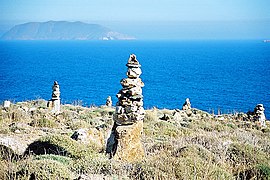Anafi
|
Anafi Ανάφη |
|
|---|---|

Anafi hillside
|
|
| Coordinates: 36°22′N 25°47′E / 36.367°N 25.783°ECoordinates: 36°22′N 25°47′E / 36.367°N 25.783°E | |
| Country | Greece |
| Administrative region | South Aegean |
| Regional unit | Thira |
| Area | |
| • Municipality | 40.370 km2 (15.587 sq mi) |
| Highest elevation | 584 m (1,916 ft) |
| Lowest elevation | 0 m (0 ft) |
| Population (2011) | |
| • Municipality | 271 |
| • Municipality density | 6.7/km2 (17/sq mi) |
| Time zone | EET (UTC+2) |
| • Summer (DST) | EEST (UTC+3) |
| Postal code | 840 09 |
| Area code(s) | 22860 |
| Vehicle registration | EM |
| Website | www.anafi.gr |
Anafi (Greek: Ανάφη) is a Greek island community in the Cyclades. In 2011, it had a population of 271. Its land area is 40.370 square kilometres (15.587 square miles). It lies east of the island of Thíra (Santorini). Anafi is part of the Thira regional unit.
According to mythology, the island was given the name Anafi because Apollo made it appear to the Argonauts as a shelter from a bad storm, using his bow to shed light upon it (i.e. the island name Ἀνάφη is derived from ἀνέφηνεν, "he made appear"). If the name of the island derives from this word, and means "revelation", then Anafi is linked to Delos, an island whose name also derives from an ancient Greek word meaning "to reveal". Others say that the name is due to the non-existence of snakes on the island: "an Ophis" ("without snakes"). Despite its small size, Anafi offers archaeological as well as mythological interest. At the monastery of Panagia Kalamiotisa there are ruins of a temple built as an offering to the god Apollo Aegletus. Some of the inscriptions from the island (Inscriptiones Graecae XII, 248 line 8) refer to the god Apollo as "asgelatos" ασγελατος, a unique usage, said by some scholars to be a variant of Aigletes, radiant. However, one scholar (Burkert 1992) links this epithet to a Sumerian goddess of healing and to Apollo's son Asclepius. Ruins can also be found at Kasteli, and most of the findings, such as the statues, are now located at the "Archaeological Museum" at the Chora, in an extremely small room. In Roman times the island was used as a place of exile.
After the Fourth Crusade in 1204, when the Cyclades were taken over by Venetians, Anafi was granted by Marco I Sanudo to Leonardo Foscolo. In the late 1270s, the island was recovered for the Byzantine Empire by Licario and another Italian renegade and native of Anafi, John de lo Cavo, who succeeded Licario as imperial admiral in the Aegean. In 1307 the island was captured by Januli Gozzadini, of Bolognese origin, who established himself as its independent lord. Much later the ruler of Anafi, William Crispo (1390-1463), became regent of the Duchy of the Archipelago, leaving Anafi under the control of his daughter Florence. William is said to have built the fortifications (kastro) above the present village. He is also claimed to have built a fortress, sometimes referred to as "Gibitroli", on Mount Kalamos.
...
Wikipedia


